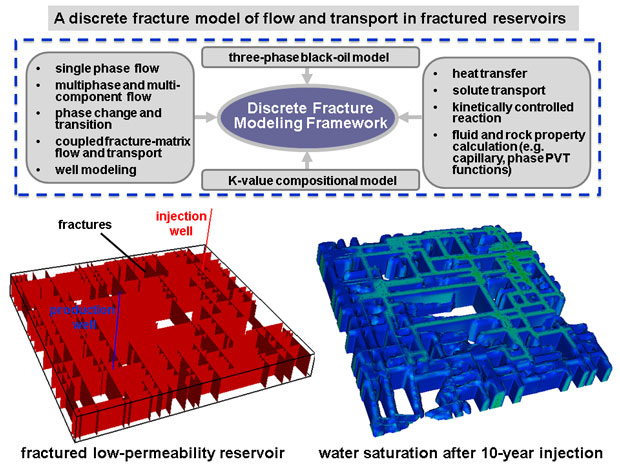Yue Hao (16-ERD-014)
Project Description
From deep, geological storage of carbon dioxide and geothermal energy extraction to subsurface radionuclide or contaminant migration, understanding multiphase flow and transport in fractured media is a critical requirement. A recent and important example of multiphase flow between fractures and matrix rocks is related to hydraulic fracturing (fracking), which involves drilling and injecting aqueous fluids at high pressures into low-permeability shale rocks. This process creates new fractures or reactivates existing fracture networks to maximize formation permeability for enhanced shale gas or oil production. Despite recent and widespread commercial successes of this approach, two major issues challenge current hydraulic fracturing operations. First, newly fractured unconventional wells experience a much faster production decline than conventional wells, requiring continuous drilling and re-fracturing to remain economically viable. Second, large amounts of injected fluids are lost within reservoirs during hydraulic operations, driving up already high costs and increasing potential risks for environmental damage. We will develop a high-fidelity discrete-fracture model to simulate multiphase flow in fractured shale rocks. This research would represent a major advance in simulating fractured shale reservoirs, helping interpret field data that cannot be well explained by current models. We plan to develop a discrete-fracture multiphase flow model with improved physics, as well as an up-scaling method from discrete fracture to continuum models. In addition, we will couple hydraulic-fracture and flow models. Such work has the potential to enhance a wide range of energy, national security, and environmental programs such as unconventional hydrocarbon recovery, enhanced geothermal systems, geological carbon dioxide storage, and subsurface radionuclide or contaminant migration such as the Comprehensive Test Ban Treaty on-site inspection and Underground Test Area projects.
We expect to provide an improved understanding of the physical processes that influence shale gas and oil production and hydraulic fracturing, as well as a first-of-a-kind flow-modeling capability including discrete fractures and improved physics that governs multiphase flow processes in fractured shale reservoirs. Specifically, we intend to (1) develop a numerically robust discrete-fracture multiphase flow model in the GEOS hydraulic fracturing simulator to improve fidelity and accuracy in representing fracture–matrix interactions (see figure); (2) include physical models of relevant multiphase flow phenomena within the discrete-fracture model to capture flow and transport in discrete fractures and surrounding low-permeability rocks; (3) develop an up-scaling approach to improve how multiphase flow and transport in fractured rocks can be represented in field-scale models, bridging conceptual gaps between discrete-fracture and continuum models; (4) integrate hydraulic-fracture and multiphase flow models for simulating coupled physical processes during hydraulic fracturing and hydrocarbon production; and (5) perform model validation and verification. Our models will lead to improved interpretive capabilities of shale gas and oil recovery operations, as well as a basis for upgrading legacy models for predicting and designing shale gas and oil recovery operations. In addition, we expect our simulations to provide a major advance in modeling multiphase flow in fractured media.
Mission Relevance
Our research project will provide a first-of-a-kind demonstration of discrete-fracture modeling of multiphase flow in fractured reservoirs, leading to a more accurate understanding of the physical processes that affect shale gas and oil recovery, enhancing the Laboratory's strategic focus area in energy and climate security. The resultant fully integrated geological–mechanical and reservoir modeling capability and the addition of a multiphase flow-simulation element to the GEOS hydraulic fracturing simulator also supports LLNL's high-performance computing, simulation, and data science core competency.
FY16 Accomplishments and Results
In FY16 we (1) developed a discrete fracture flow-modeling framework in the GEOS code, based on a cell-centered, multipoint flux approximation finite-volume method; (2) built a multiphase flow-model capable of capturing phase saturation discontinuity and capillary pressure at the fracture–matrix interface; (3) developed a compositional model to describe phase partition and evolution; (4) tested the discrete fracture flow-modeling capability for enhanced geothermal system applications; and (5) continued to develop, improve, and validate the physical sub-models.
Publications and Presentations
- Hao, Y., et al., Modeling of chemically-induced fracture permeability evolution and its impact on geothermal energy production. Geological Society of America Ann. MTG. in Denver, CO, Sept. 25–28, 2016. LLNL-PRES-703502.
- Hao, Y., et al., The effect of fracture-matrix interactions on multiphase flow in fractured reservoirs: Development of a discrete fracture model. XXI Intl. Conf. Computational Methods in Water Resources, CMWR 2016, Toronto, Canada, June 20–24, 2016. LLNL-PRES-692724.






